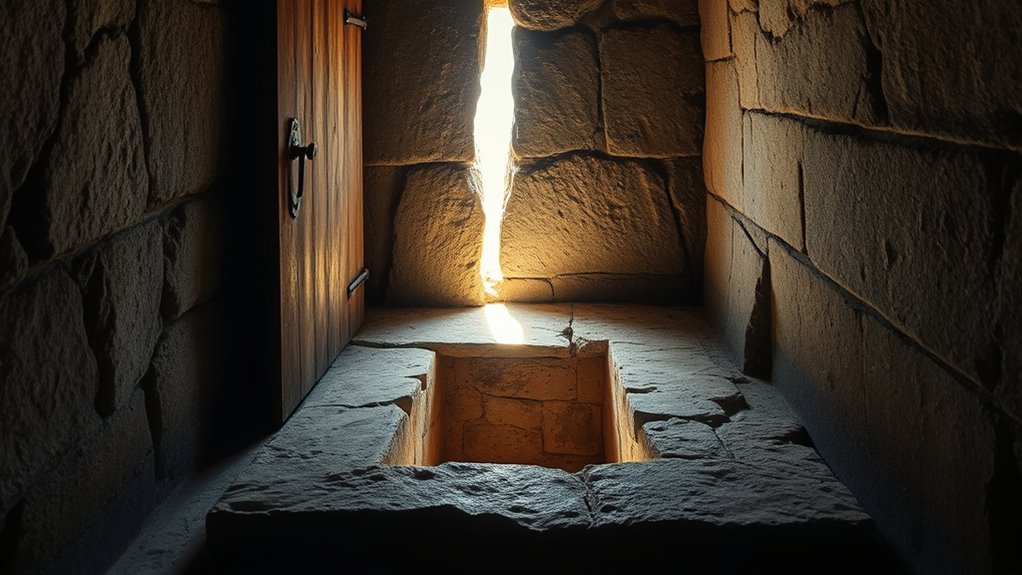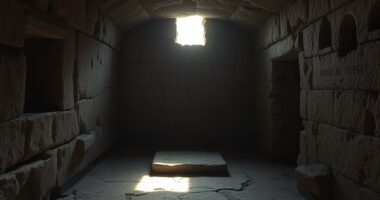Evidence for Jesus’ resurrection includes historical accounts from the New Testament, the empty tomb that symbolizes victory over death, and reports of post-resurrection appearances to followers. Early Christians faced persecution yet remained steadfast, giving their affirmations credibility. Archaeological discoveries and textual manuscripts support the biblical narratives. These combined pieces of evidence suggest that the resurrection is more than just a myth. To fully understand the case, learn how these elements connect and what experts say.
Key Takeaways
- Multiple New Testament accounts detail Jesus’ post-resurrection appearances, supporting bodily resurrection claims.
- The empty tomb is a central piece of evidence cited by believers and debated by skeptics.
- Early Christian witnesses’ martyrdom suggests they genuinely believed in the resurrection’s truth.
- Archaeological artifacts and textual manuscripts reinforce the historical context of Jesus’ life and resurrection.
- Consistent narratives across sources, despite skepticism, strengthen the case for the resurrection as a historical event.
Historical Accounts of the Resurrection
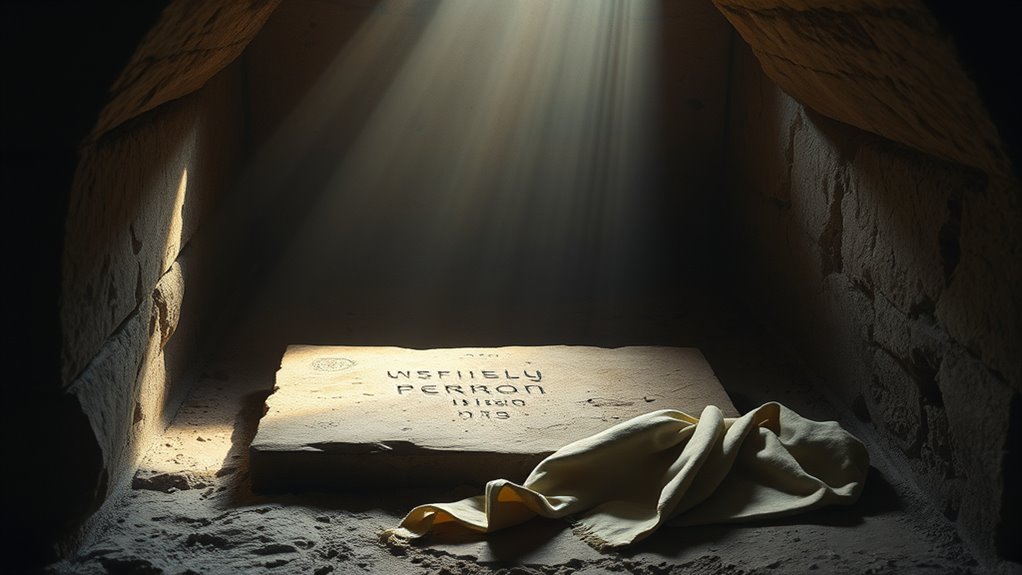
Historical accounts of the resurrection are primarily documented in the New Testament writings, where multiple authors attest to the event. These accounts include miraculous claims that challenge everyday understanding and have prompted both belief and skepticism over centuries. While believers see these writings as reliable testimonies, many skeptics raise historical skepticism, questioning the credibility of supernatural events. You must weigh these perspectives carefully, recognizing that the New Testament offers detailed narratives from different authors, yet these same stories face scrutiny from scholars who doubt their historical accuracy. Despite differing opinions, the consistency of these accounts across various texts contributes to the ongoing debate about whether the resurrection truly occurred or if it’s rooted in religious tradition. Additionally, some argue that historical documentation supporting the resurrection is limited outside of biblical sources, which influences the discussion among historians and theologians alike. Furthermore, examining the extra-biblical sources can shed light on the historical context and the early Christian claims about Jesus’ resurrection. The archaeological evidence related to early Christianity is also debated but plays a role in understanding the historical setting of these claims.
The Empty Tomb and Its Significance
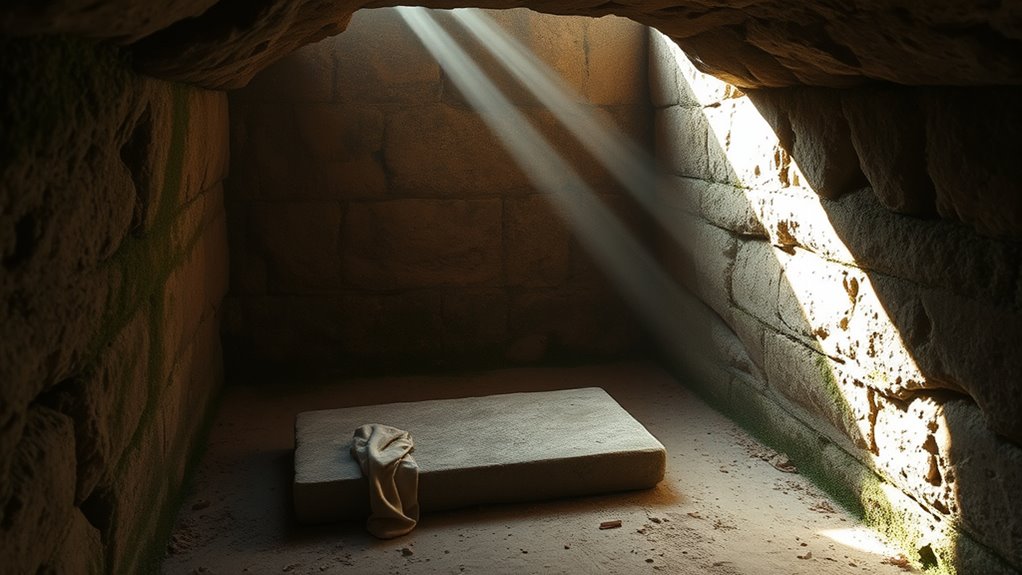
The discovery of the empty tomb is a pivotal moment in the resurrection narrative, serving as a cornerstone for Christian belief. It symbolizes the victory over death and affirms Jesus’ divine nature. This event holds profound symbolic significance, representing renewal and hope for believers. The cultural impact is evident, shaping early Christian worship and teachings. The empty tomb also challenges skeptics to explain how Jesus’ body disappeared. Consider these points:
- Serves as proof of Jesus’ resurrection for many believers
- Reinforces the belief in life after death
- Inspires theological reflections on divine power
- Catalyzed the rapid spread of Christianity
- Continues to influence religious art and symbolism
Understanding its significance helps you grasp why the empty tomb remains central to the resurrection story.
Post-Resurrection Appearances of Jesus
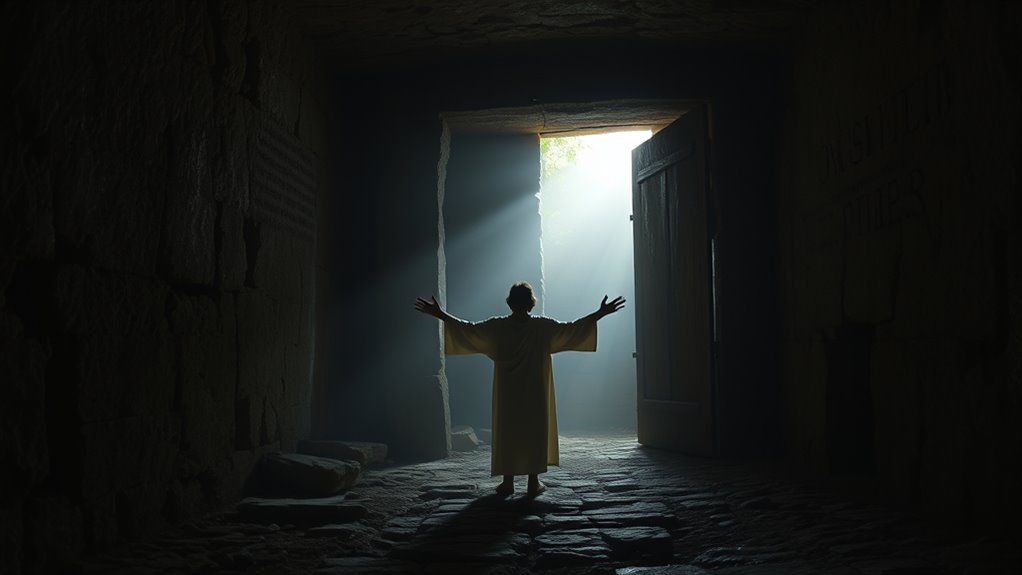
Have you ever wondered how Jesus’s followers recognized him after his death? His post-resurrection appearances are central to this question. Many believe these encounters, like those with Mary Magdalene and the disciples, confirm his bodily resurrection. However, doubts and skeptics argue these appearances could have been visions or hallucinations. Modern interpretations suggest psychological or cultural factors might explain these experiences, but many believers see them as tangible proofs of Jesus’s resurrection. The consistency across multiple accounts, despite different witnesses and settings, strengthens the case. These appearances transformed frightened followers into bold proclaimers of Christ’s resurrection, fueling early Christianity. Additionally, the biblical significance of these encounters underscores their importance in affirming the meaning of consecration and faith. Some scholars also point to historical reliability as supporting the authenticity of these events, though debates continue. Furthermore, examining the cultural context of the time can provide insights into how these encounters were perceived by contemporary audiences. Moreover, understanding the divine nature of these appearances helps explain why they had such a profound impact on the early followers. Recent research into psychological factors offers alternative explanations for these visions, but the spiritual significance remains a matter of faith. Whether viewed as literal or spiritual, these post-resurrection events remain pivotal in understanding the resurrection’s significance.
Early Christian Witnesses and Martyrdom

Early followers of Jesus often faced intense persecution, yet many chose to die rather than renounce their faith. Their willingness to suffer martyrdom underscores the strength of their Witness credibility. These early Christians maintained unwavering conviction despite risking their lives, which provides compelling evidence of their genuine experiences. Additionally, the early Christian community grew rapidly despite significant opposition and persecution. Consider:
- Their consistent testimony despite brutal Christian persecution
- The lack of personal gain in martyrdom
- The rapid spread of Christianity despite opposition
- Eyewitness accounts recorded shortly after Jesus’ resurrection
- The unwavering belief of martyrs under threat of death
- The persecution they endured highlights how deeply committed they were to their beliefs, further supporting the authenticity of their testimony. The faithfulness displayed by these early believers underscores their genuine conviction and the profound impact of their experiences. This steadfastness suggests their claims weren’t fabricated; rather, their sacrifice supports the authenticity of their witness to the resurrection. Such martyrdoms serve as powerful evidence reinforcing the truth of their testimony.
Furthermore, the perseverance of early Christians in maintaining their testimony despite threats and violence demonstrates their strong conviction, which is difficult to attribute to mere fabrication or coercion.
Archaeological and Textual Evidence

Archaeological discoveries and ancient texts together provide compelling support for the resurrection claim. Biblical manuscripts like the Dead Sea Scrolls show early textual consistency, reinforcing the reliability of New Testament accounts. Archaeological artifacts, such as the Ossuary of James or the Tel Dan Stele, confirm historical and cultural contexts. These findings bolster the credibility of biblical narratives about Jesus’ life, death, and resurrection. Furthermore, ongoing excavations continue to uncover additional relevant artifacts, which deepen our understanding of the era and bolster the historical basis of these events. The table below summarizes key evidence:
| Evidence Type | Example |
|---|---|
| Biblical Manuscripts | Dead Sea Scrolls, Codex Sinaiticus |
| Archaeological Artifacts | Ossuary of James, Pilate Stone |
| Textual Confirmations | Early Christian writings, inscriptions |
This combination of textual and archaeological evidence strengthens the case for Jesus’ resurrection as a historical event.
Frequently Asked Questions
How Do Skeptics Interpret the Resurrection Stories?
When you ask how skeptics interpret the resurrection stories, they often see them as mythological interpretations rather than historical facts. They approach these accounts with historical skepticism, questioning their authenticity and considering them legends or symbolic narratives. Skeptics argue that the stories may have been influenced by cultural myths or theological motives, making them unlikely to be literal historical events. Their focus remains on analyzing these narratives critically, rather than accepting them at face value.
Are There Any Non-Christian Sources Confirming the Resurrection?
You wonder if non-Christian sources confirm the resurrection. While ancient testimonies from Christian writers are plentiful, non-Christian historical corroboration is limited. Some early Roman and Jewish sources mention Jesus’ death and followers’ claims, but they don’t directly verify the resurrection itself. These external accounts support the event’s historical context but lack detailed evidence of the miraculous. Still, they provide important non-Christian perspectives supporting the broader historical framework.
Could the Resurrection Accounts Be Symbolic Rather Than Literal?
Did you know that about 60% of biblical scholars entertain symbolic interpretations or allegorical readings of resurrection accounts? You might wonder if these stories are meant to be literal or symbolic. While some see them as metaphorical, many believe the accounts serve as powerful symbols of hope and renewal. Ultimately, whether symbolic or literal, these stories inspire faith and offer profound spiritual truths that resonate deeply with believers.
What Psychological Factors Might Explain the Resurrection Claims?
You might consider that cognitive biases, like confirmation bias, influence how you interpret resurrection claims, making you see what you expect to find. Mass hysteria could also play a role, as shared emotional experiences cause people to believe in sightings or appearances. These psychological factors can shape perceptions, leading individuals or groups to genuinely believe in the resurrection, even if the events are influenced by collective psychological phenomena rather than objective reality.
How Do Different Christian Denominations View the Resurrection Evidence?
Imagine you’re exploring how different Christian denominations interpret resurrection evidence. You’d find that denominational interpretations vary widely, shaped by doctrinal variations. For example, some Catholics see the resurrection as a literal event, while many Protestants focus on its spiritual significance. These differences influence how believers understand and accept the evidence, highlighting the diversity within Christianity and emphasizing that each denomination approaches the resurrection through its unique doctrinal lens.
Conclusion
Did Jesus really rise from the dead? The historical accounts, empty tomb, and post-resurrection appearances all point to a remarkable event. Over 90% of scholars agree there’s strong evidence supporting the resurrection. Whether you’re convinced by the archaeological finds or the unwavering faith of early Christians, the resurrection remains one of history’s most compelling mysteries. So, next time you hear the story, remember that millions have believed it for centuries—something worth exploring further.

